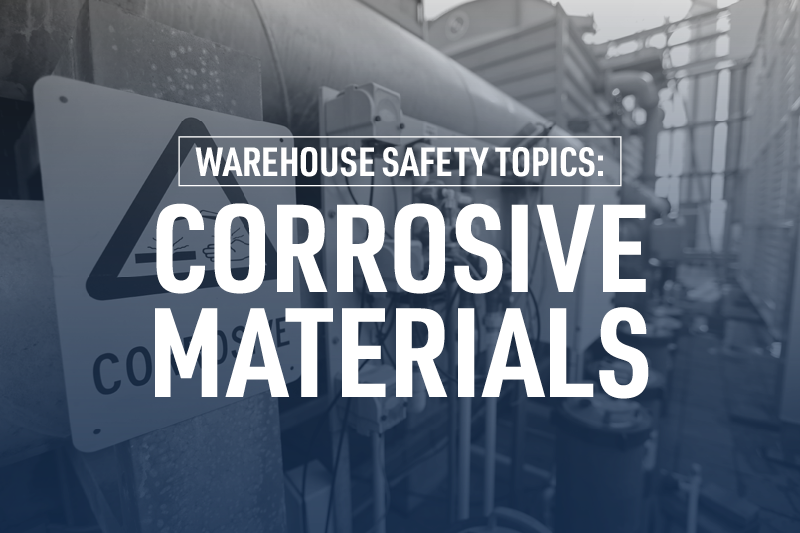
Warehouses can be dangerous places. The US Bureau of Labor Statistics reports over 38,000 accidents occur in warehouses each year. Consequently, safety is an enormous part of the material handling industry. Equipment safety is widely discussed. However, material safety doesn't always receive the same attention. So, we'd like to share some warehouse safety tips about corrosive materials, a hazardous substance found in almost every facility. Read on to learn more about corrosive chemicals and how to stay safe when working with them.
What Are Corrosive Materials?
OSHA defines a corrosive material as a chemical that causes visible destruction of, or irreversible alterations in, living tissue by chemical action at the site of contact. Corrosive substances include chemicals used in many industries, from household bleach to hydrofluoric acid. These materials can be liquid, solid, or gaseous. They are divided into two broad categories: acids and bases. Acids have a very low pH and include compounds like acetic acid. Bases are alkaline and have a high pH. They include common materials like lime.
All corrosive substances are hazardous. If incorrectly handled, they pose a severe risk to the eyes, skin, respiratory tract, and gastrointestinal system. Between 2021 and 2022, accidental exposure to harmful substances, including corrosive materials, caused 634,080 lost work days in the US alone.
Warehouse Safety Tips for Corrosive Substances
Worker safety is everyone's job. Let's discuss some warehouse safety tips for managing and handling corrosive chemicals in your facility.
Containers for Corrosive Substances
Corrosive materials require proper storage to protect yourself and your team from accidental exposure. The OSHA corrosive storage requirements detail all the necessities of safe storage. Thoroughly review them before introducing corrosive chemicals into your facility. However, three essential requirements deserve special attention:
- Permissible Exposure Limits (PELs). OSHA defines PELs for corrosive materials, though certain states impose stricter limits. Containers used for corrosive storage should prevent exposures beyond these limits.
- Hazard Communication. OSHA requires that all workers and users be informed about any hazards posed by chemicals. This includes signage that complies with the Globally Harmonized System of Classification and Labeling Chemicals (GHS). Additionally, the US Department of Transportation requires all containers holding corrosive substances to display their placard, which illustrates the effect of a corrosive substance contacting skin.
- Separate Storage. Corrosive material storage must be a safe distance away from non-compatible chemicals and processing areas. Compatibility will vary depending on the corrosive chemical, but acids should not be stored with bases. However, some corrosives are safe to store with flammable compounds.
Material Safety Data Sheet
The material safety data sheet (SDS) is a document created by the chemical manufacturer that identifies the substance and outlines its associated hazards. This document will help you determine if a particular chemical qualifies as a corrosive material and provide information regarding incompatible chemicals for storage purposes. Once the corrosive arrives at your facility, the SDS must be on file and available to all workers and users of the corrosive.
PPE for Corrosive Substances
Different corrosives may require different personal protective equipment (PPE). At a minimum, workers should wear gloves, chemical-resistant clothing, and eye protection when working with corrosive materials. Nitrile gloves are often recommended, but nitrile is unsuitable for some corrosives. Check the SDS for PPE recommendations.
Handling gaseous corrosives requires special precautions. These materials pose a significant hazard to the respiratory tract. Thus, workers must wear appropriate respiratory protection. Additionally, handling should occur in chemical fume hoods whenever feasible.
Working With Corrosive Substances
How to handle corrosive substances will vary depending on the chemical. Be sure to thoroughly review the SDS before handling any corrosive material. However, some best practices are largely universal.
- Corrosion-Resistant Construction. In work areas, use only infrastructural features such as racking, flooring, and walls constructed from corrosion-resistant materials.
- Safety Precautions. Work areas must be well-ventilated and marked with proper warning signs. A chemical fume hood is often recommended.
- Dispensing. Handle and dispense corrosives with care. Keep containers closed when not in use and exercise caution when transporting to avoid accidental exposure.
- Handling. When mixing corrosives and water, use cold water and always add the corrosive to the water, not vice versa. This prevents the corrosive compound from splashing and dangerously overheating during mixing. The adage "Always Add Acid" will help you remember this, but the rule also works for bases.
- Disposal. Dispose of corrosive compounds and solutions containing corrosives in appropriate containers. Improper disposal can create hazardous mixtures that pose a significant danger to your team.
Preventing and Preparing for Emergencies
No matter how careful your team is, accidents happen. Ensure your team minimizes the risk of accidental exposure through good housekeeping and equipment maintenance. Team members must also receive training in emergency procedures to handle spills, fires, and injuries. Make spill kits available in workspaces and ensure your team knows how to use them.
Additionally, OSHA requires emergency flushing stations in all areas where accidental exposure to corrosives may occur. These stations often take the form of eye washes and showers. Inspect and flush these regularly to maintain emergency preparedness.
Where To Find More Warehouse Safety Tips
As your material handling partner, we're more than just a forklift dealer. Since 1919, our mission has been to support you with the most innovative and useful products on the market. That goes well beyond forklifts and scissor lifts. We consider it our responsibility to share our 100+ years of industry experience with you. Likewise, we hope you'll share these important warehouse safety topics with your team. So, if you have a question about how to improve safety in your facility, contact us online or visit one of our Mid-South locations:
Arkansas - Jonesboro
Alabama - Birmingham, Dothan, Irondale, Madison, Mobile, and Montgomery
Mississippi - Tupelo, and Richland
Tennessee - Jackson, Memphis, Knoxville, and Kingsport
Further Reading
Bollards, Guardrails and 3 More Money-Saving Warehouse Safety Products
Different Types of Pallet Racking
Ladder Safety: Can Your Business Afford a Lawsuit or OSHA Citation?
Posts by Tag
- Forklift (61)
- Forklift Service (19)
- Electric Forklifts (16)
- Forklift Safety (14)
- Forklift Attachments (12)
- Toyota Forklifts (12)
- Warehouse Planning (10)
- Parts (9)
- Warehouse Automation (8)
- Clark Forklifts (7)
- Loading Docks (7)
- Material Handling Education (7)
- Pallet Racking (7)
- Customer Solutions (6)
- Forklift Batteries (6)
- Forklift Rental (6)
- Purchasing Options (6)
- Aerial Equipment (5)
- Heavy Equipment (5)
- Forklift Accessories (4)
- Forklift Fleet Management (4)
- Forklift Tires (4)
- Forklift Training (4)
- Products (4)
- Utility Vehicles (4)
- Yard Spotter Trucks (4)
- Linde (3)
- Pallet Jacks (3)
- Specialty Forklifts (3)
- Used Equipment (3)
- IC Forklifts (2)
- Manitou (2)
- Warehouse Doors (2)
- COMBiLift (1)
- Custom Shop (1)
- Forklift Brakes (1)
- Forklift Warranty (1)
- Gehl (1)
- Komatsu (1)
- Product Review (1)
- Recruitment (1)











